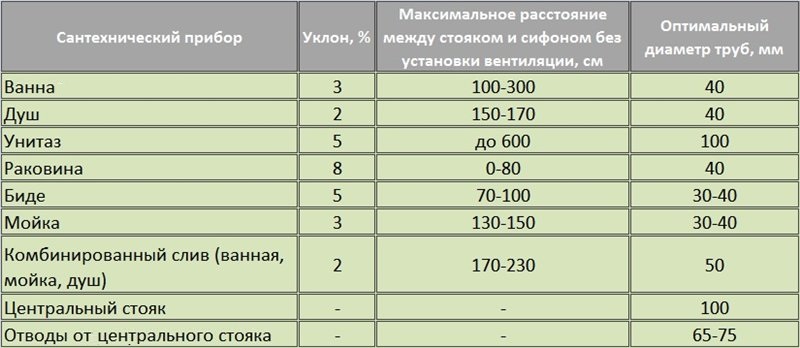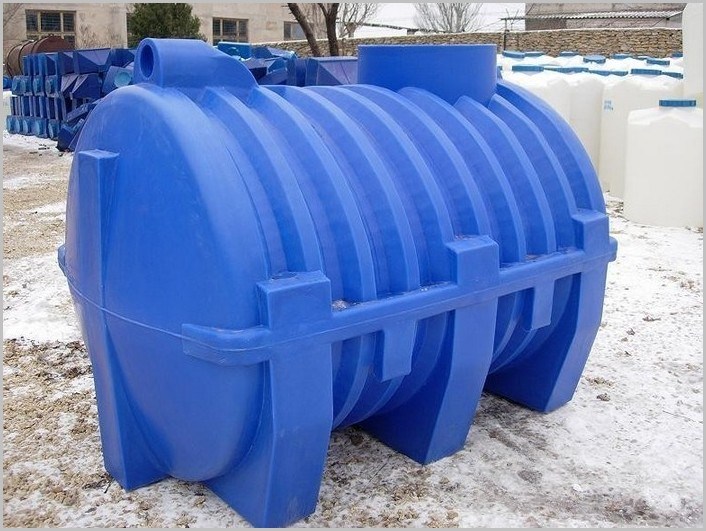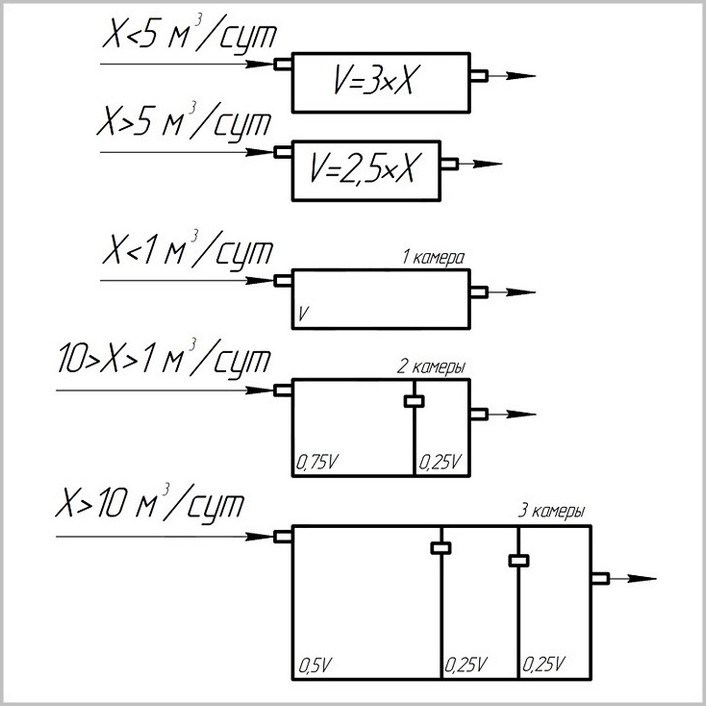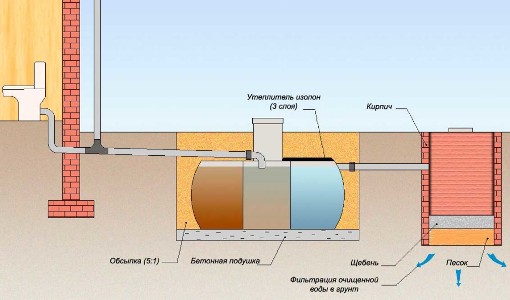How to calculate the dimensions correctly
To such a concept as size, such data can be applied as:
- Length;
- Width;
- Height.
This is important in order to make the right pit, you need to make a septic tank calculation along with all its additional details. And in order to find out the volume of drains per day, you need to look at the size of the hull and tanks
If this is a one-piece design, then you can estimate the size of the equipment according to the technical data on the package and compare them with the dimensions of your summer cottage or private premises.
Norms and rules when designing a septic tank installation for a summer residence:
- If you have a small area, then perhaps the calculations of another apparatus will come in handy;
- To make the correct calculations, you can use the tables of engineers;
- The minimum working depth should be - 1.3 m, and the width is less than 1 m;
- The depth from the surface to the bottom should be no more than 3.2 m.
Calculation of the volume of a septic tank
How many ways are there to calculate volume? This is what we know now.
After all, it is very important to buy optimal septic tanks, the calculation of which is the main criterion for their purchase
There is a standard formula for calculating the volume of a septic tank:
Now let's write all the components of the formula:
W
- Calculation of the required dimensions of the sump in cubic meters (m3); t
– Time spent processing or storing sludge (days); C
– Number of suspended particles in ml per 1 liter (mg/l);N
– Daily norm of a person (l / day); T
– Drain temperature (˚С);Q
– Water consumption in cubic meters per day (m3/day).
According to this formula, we calculate the unit we need.
As for the temperature of the drains in the sewer, you need to remember that it will not be the same as in the room. This largely depends on the plumbing fixtures that are used in enterprises. But there are accepted norms, for example, in winter - 10 ˚С, and in summer - 15-20 ˚С. This greatly simplifies the calculation of the formula.
There are many different tables that can be prepared with data that is produced by engineers. Basically, these are averages.
If you take data from the table, then the calculation should look like this:
W = K x Q,
K - estimated time of settling wastewater (table);
Q
- the amount of stocks per day.
There is also a more simplified version of determining how much the device will have to contain. It is necessary to multiply the number of people by 200 liters (daily rate for 1 person) and 3 days (waste processing time) and divide the resulting amount by a thousand - this should be the calculated volume (in cubic meters).
Average statistics show that the daily norm per person is 200 liters of water. For unforeseen expenses, the same amount of water is usually added. And then for a two-tank septic tank that defends water for 2 days, the formula looks like this:
(N x 200+200) x 2
N - The number of people who live in the house.
Simplified calculation of a septic tank according to the daily volume of effluents
The liquid part of the wastewater is retained in the septic tank for 3-5 days, after which the clarified water leaves the working chambers, overflowing into filtration fields or absorption wells. The solid insoluble fraction will linger at the bottom of the sump until the next pumping of bottom sludge. Degradable waste is transformed into water and gas in six months.
Therefore, the most convenient way to determine the total volume of a septic tank is the simplest tripling of daily flows, which can be determined either in-situ - according to the average readings of the "counter" of water consumption.
However, the specified method for calculating a septic tank is effective only if the volume of daily effluents does not exceed 5 cubic meters.
Calculation of the volume of a septic tank by the number of users
Obtaining data on the average daily volume of wastewater without the ability to use the sewer network, which simply does not work without a septic tank, is an almost impossible task.
Therefore, instead of in-situ determination of the volume of daily effluents by the meter, most home-grown designers use the method of calculating according to sanitary standards for water consumption.
These norms suggest that the maximum amount of daily water consumption per person ranges from 125 to 350 liters. That is, a family of 2 people consumes from 250 to 700 liters of water per day. And the volume of effluents in the sewer serving a family of 4 reaches 500-1400 liters per day.
As a result, using the method of tripling the daily volume of effluents, we get the following result:
- The volume of a septic tank serving 1-2 users is 0.75-2.1 m3.
- The volume of a septic tank serving 3-4 users is 1.5-4.2 m3.
However, according to professional system designers, this way of calculating volume is far from ideal. Indeed, in this case, we do not take into account either the mass of insoluble sediments, or the volume of bottom silt, or other important factors.
Engineering calculation according to the formula for the optimal volume of the sump
An accurate determination of the volume of a septic tank is possible only by the following formula:
At the same time, Q - the daily volume of effluents - is determined by sanitary standards and the number of users,
C - the concentration of suspensions in wastewater - is determined from the table,
N - the sanitary norm of water supply for one user - is taken from SNiP.
The shelf life of precipitation - t - is determined according to the tables of natural decay, and the temperature of the effluents - T - is taken equal to 10-12 degrees Celsius.
However, this method of calculating the volume of a septic tank is justified only in the case of designing a sewer network for a cottage settlement or an apartment building. At the household level, which assumes the possibility of an error in the calculations, such accuracy can be neglected, since deviations of ± 0.5-1 cubic meters will not bring significant damage to either the efficiency of the system or the owner's wallet.
Features of the device of multi-chamber septic tanks
The above methods for calculating the septic tank relate to the total volume of the septic tank. Meanwhile, in modern settling tanks there are at least two chambers. A more or less effective scheme involves dividing the internal volume into three chambers - primary, (gravity), secondary (aerobic) and a fine cleaning zone, on top of which an aerator with a biological load is also mounted.
Scheme of installation of a three-chamber septic tank
At the same time, the primary chamber for gravitational wastewater treatment should occupy at least 50 percent of the total volume of the septic tank. The secondary settling tank and the wastewater treatment chamber each occupy 25 percent of the total volume. The aeration zone is mounted in a separate module installed on top of the septic tank.
The volume of a two-chamber septic tank is divided in a 3:1 ratio - the primary gravity cleaning chamber occupies 75 percent of the total volume, and the aerobic fermentation zone - only 25 percent.
As a result, in a three-chamber septic tank with a volume of 4.2 m3, the primary chamber cannot be less than 2.1 cubic meters, and the secondary septic tank and the post-treatment zone will take 1.05 "cubic meters" each. A two-chamber septic tank of the same volume will be divided into two zones: a gravity chamber with a volume of up to 3.15 m3 and an aerobic chamber with a volume of up to 1.05 cubic meters.
https://youtube.com/watch?v=PtYFGdU6gaI
Pipe selection

During the laying of the sewerage system of a private house, circular cross-section water ducts with an internal diameter of 40 to 110 mm are used from polyvinyl chloride resistant to aggressive wastewater environments. Since various plumbing and household appliances are characterized by an unequal volume of drains that differ in consistency and composition, pipes with the following internal diameters are used:
- washbasins, kitchen sinks - 40-50 mm;
- bathtubs, shower trays - 50 mm;
- washing machines and dishwashers - 50 mm;
- urinals, bidets - 50 mm;
- toilets - 110 mm.
If a private residential building has 2 or more floors, the upper bathrooms are connected to the lower sewers using vertically located communications - risers - with an internal diameter of 110 mm.
Example calculation of a septic tank for a family of 4 people
For example, you can consider the option of calculating a septic tank for servicing a house where 4 people live permanently.
It is easy to calculate this by the formula: 3 x Q, where Q is the water consumption per day. The amount of time that a septic tank needs to process wastewater can be calculated as follows:
0.8 x t x (100% - 30% / 100%) x 120% \u003d 0.8 x t x 0.7 x 1.2 \u003d t x 0.672 sec.
0.8 - consumption of solid residue of processed wastewater, calculated per person; t - terms of decay of solid residues in days; 100% - total volume of sludge; 30% - percentage of natural decay of sludge; 120% - 100% of the total volume of sludge + 20% sludge residues after the previous cleaning of the septic tank.
In order to get a closer look at the calculations per person of water consumption per day, you must first determine the amount of use of plumbing equipment, as well as the frequency of use of plumbing equipment in the house.
Photo: the amount of use of plumbing equipment
Let's take for calculations for one person the minimum cost of water - 150 l / day.
So, for example, the average consumption and consumption of water by one person can form the following picture:
- one minute of taking a shower will consume about 10 liters of water;
- taking a shower or bath on average is about 7-15 minutes;
- when using a bidet or toilet, water consumption is about 8 liters;
- the average use of a bidet is 5 minutes;
- one bath or jacuzzi has to spend water in the amount of 110 liters;
- a washing machine with a load of 2 kg of laundry consumes water in the amount of 70 liters per row;
- A dishwasher consumes 15 liters of water per cycle.
Let's try to calculate the water consumption per person, at least by using a shower, bidet and bath:
(150 + 10 x 7 + 8 x 5 + 110) = 370 l / day.
Thus, from the minimum indicator of daily water consumption by one person, we reached the maximum indicator of daily water consumption by one person - 370 l / day.
Both indicators, minimum and maximum, are indicated in SNiP 2.04.09-85, which indicates the correctness of the calculations.
Now let's calculate the total consumption (Q) when consuming water, including a washing machine and a dishwasher, for 4 people permanently residing in the house:
Q \u003d 370 x 4 + 70 + 15 \u003d 1565 \u003d 1.6 cubes per day
Given the previous formula for calculating the volume of a septic tank - 3 x Q, we can now calculate the volume of a septic tank to serve a family of 4 people:
3 x 1.6 = 4.8 m3
4.8 m3 in this situation is the most optimal indicator for calculating the volume and size of the septic tank. If it is necessary to take into account the minimum size of the septic tank, then you can use the following calculations:
4.8 x (1-0.2) = 3.84 m3
This must be done in cases where it is necessary to reduce the size of the septic tank to its minimum use with the number of 4 permanent residents.
The formula for calculating the reduction uses only the allowable rate of wastewater treatment less than 20%, more can not be reduced.
If this assumption is violated, emergency flooding of the septic tank, poisoning of the soil and the environment and, as a result, the imposition of high fines by state institutions can occur. Who will have every right to do so.
To calculate the required depth for the construction of a septic tank that will have to serve a family of 4, you can use the following standard calculations:
4.8 / 1 / 1.8 - 2.6 meters, where
4.8 - cubic meters of the volume of the septic tank; 1 - meter of the width of the septic tank; 1.8 - meters along the length of the septic tank.
Such a measure may be necessary if your personal plot is limited in area, and you cannot give a lot of land for building a septic tank.
In some regions of Russia, the depth of soil freezing is about 2 meters or more.
Any violation or deviation from the norms and rules adopted in the state documentation of SNiP leads, as a rule, to a complete stop in the operation of a particular septic tank, as well as to the imposition and payment of penalties in large amounts provided for by the legislation of the Russian Federation.
Important! Therefore, before the construction or installation of finished treatment equipment, it is necessary to clearly trace all the rules and regulations for the installation of autonomous sewers, which can be found, first of all, in SNiP 2.04.03-85 “Sewerage. External networks and facilities” and other regulatory documents
It is also necessary to make a number of correct and accurate calculations on the volume of water consumption, the volume of the septic tank, its design and installation parameters
External networks and structures” and other regulatory documents. It is also necessary to make a number of correct and accurate calculations on the volume of water consumption, the volume of the septic tank, its design and installation parameters.
Calculation of dimensions and volume
To accurately determine the internal space of the tank, a specially developed formula for calculating the volume of a septic tank is used. But it implies a large number of complex meanings and is difficult for private practical application. In practice, the volume of a septic tank for a private house is calculated using a simpler formula. Number of people X 200 liters of sewage per person X 3 days (waste processing time) / 1000 = volume in cubic meters.

To serve 4 people, a septic tank with a volume of 2.4 cubic meters is required.
Consider the option with the calculation of the volume for this number of family members.
When calculating the “number of people” parameter, it is better to take it “with a margin” in order to take into account the load when visiting guests and other unforeseen situations. The daily rate can be increased if there are small children, pets. This indicator also increases if you use a large number of different household appliances with water consumption (washing machine).
As mentioned above, there are laboratory calculations that are given for factory septic tanks. According to these data, it is possible to carry out calculations in situations with containers made independently.
So, with a septic tank in three sections:
- for two people, a useful volume of 1.5 cubic meters is required. m.;
- for three or four people - 2 cubic meters. m.;
- for five or six people - 3 cubic meters. m.;
- for eight people - 4 cubic meters. m.;
- for ten people - 5 cubic meters. m.;
- for twenty people - 10 cubic meters. m.
Concrete rings are the main building material in the arrangement of a septic tank. And the key calculation is the determination of the amount of these materials. Most often, 3 reinforced concrete rings with a diameter of 1.5 m and a height of 0.9 m are enough. More than 5 rings are not used per septic tank.
Do not forget about other elements in the independent arrangement of the system. These include:
- Reinforced concrete slab.
- Luke.
- Pipe for ventilation.
- Cement, sand, gravel.
When calculating the required volume of a septic tank, the formulas given above are used. In addition, it is necessary to know the volume of one ring in order to determine a sufficient number of rings in the container.
V=∏R2H=∏(d2/4) H, where:
- V is the volume of the cylinder;
- ∏ is Pi number (3.14);
- R is the radius of the base;
- d is the diameter of the base;
- H is the height.
Knowing the volume of the ring, it can be compared with the obtained figures for the required volume of a concrete septic tank. The volume of 1 ring (d=1.5 m; H=0.9 m) is approximately equal to 1.6 cubic meters. m. It turns out that for 4 family members in a house with all amenities (hot water supply, etc.), 2 rings will be needed to equip a septic tank.
This amount will be enough for 5 people. Up to 10 people can be provided with one container of 3 rings. If you plan to stay from 10 to 20 people, you will need to equip a septic tank consisting of several containers, since more than 3 rings cannot be installed.In this case, it is better to take care of acquiring a factory model of sufficient volume.
https://youtube.com/watch?v=PtYFGdU6gaI
What is included in the calculation
The tasks of calculating the required volume and parameters of a particular septic tank fall not only on determining and finding the volumes and dimensions of the chambers, but also on identifying the amount of building materials, necessary tools or equipment for installation.
Therefore, in order to know exactly what parameters it is necessary to purchase or build a septic tank, what building materials may be needed, and in what quantity they are needed, the following important details should be correctly calculated:
- dimensions of the body and tanks of the factory septic tank;
- daily volumes of wastewater that the septic tank chambers can accept and process;
- calculations of the volume of water used per day, which falls on each permanently residing person in the house;
- do-it-yourself calculations of the amount of building materials for the installation and construction of a septic tank.
To ensure sanitation and preserve the cleanliness of the ecological environment, any options for septic tanks, both factory-made and home-made, should be installed after you already know exactly the parameters, dimensions of the chambers and its operational capabilities.
Important! And, of course, this must be done long before you decide to buy a ready-made septic tank from one manufacturer or another, and also procure building materials for the construction of a septic tank with your own hands.
You should take into account not only the number of permanently or seasonally residing people, but also your income, i.e. the means that you have for arranging your sewer system with one type or another of a septic tank
If you need to install a septic tank for permanent residence in a country house, then, of course, it is best to purchase a factory septic tank from a manufacturer that has proven itself in the production of high-quality sewage treatment equipment.
In any case, no matter what a septic tank-type treatment plant has to serve the house, it is necessary to determine in advance its parameters and volumes, for which it is necessary to make appropriate calculations.




